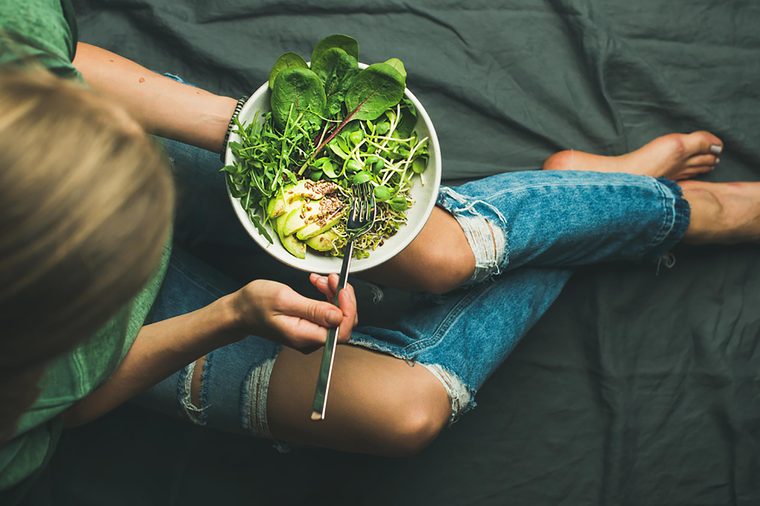
Labeling a meal as “healthy”
There are plenty of reasons why you overeat when you aren’t hungry. But how can being hungry and trying to make a healthier choice lead to accidental overeating?
When you eat something you think is healthy on the menu, chances are you’ll feel less guilty about eating it. And with less guilt surrounding a meal, you’re actually more likely to eat too much! Studies show that we consistently underestimate the calorie content of foods we think are healthy, and then overeat them because we feel like we’re making a great choice for our health.
How to fight back:
Always pay attention to your hunger and fullness cues, even when you’re eating healthy fare. Eat slowly and put your fork down after every few bites, and stop when you’re satisfied, not stuffed. These are the subtle things mindful eaters do at every meal to stay in control.
If you’re choosing between the spaghetti and meatballs that you’ll really enjoy and the spinach salad that you won’t feel guilty about, occasionally opt for the pasta, eat it with appreciation, and stop when you’re satisfied. You’ll likely end up eating fewer calories than you would if you’d scarfed down a bucket of salad—probably with fattening extras like croutons or cheese or candied nuts.
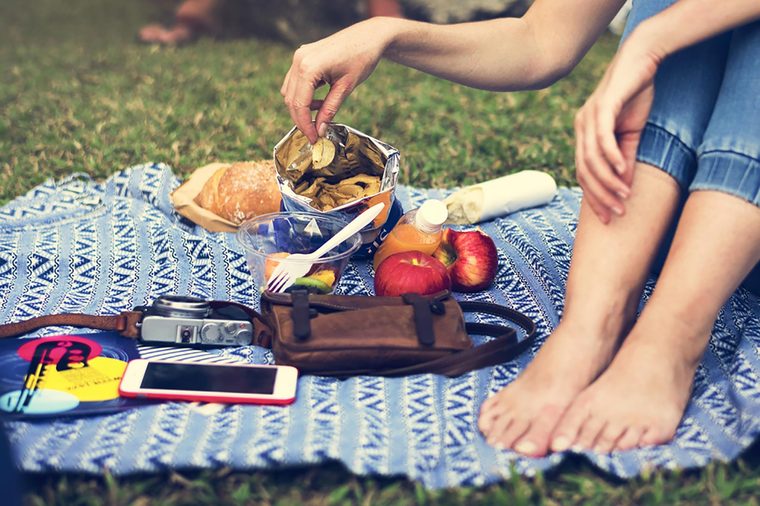
Snacking from the bag
When you have a full bag of nuts, popcorn, or other snacks in front of you, it’s all too easy to keep reaching your hand in to grab a few at a time. And before you know it, you’re touching down on bag-bottom.
When you’ve got a whole container in front of you, it’s nearly impossible to gauge how much you’ve eaten until you’ve surprised yourself by making it disappear. Don’t get tricked into eating the whole container simply because you’ve got the whole container in front of you!
How to fight back:
When you buy a family-sized container of something, separate it out into individual serving sizes—in baggies or small plastic containers—before you eat any of it. When you want to snack on the pretzels, peanuts, or whatever you’ve portioned out, grab one serving and step away from the rest. It’s much easier to resist grabbing another handful of something when it means getting up and heading back to the cupboard. Here are more tricks for eating in moderation.

Eating desserts when they appear at work
We all have that one coworker who likes to drop a box of doughnuts in the office kitchen or bake a batch of cookies to share with everyone. Not to mention the birthday cakes and other celebratory desserts that seem to show up constantly. When that happens, it’s easy to justify snagging a treat by saying “well, I don’t do this every day…” But do you do it every time pastries appear at work?
Eating when the opportunity arises, rather than when you’re actually hungry, is another way we get tricked into overeating the exact foods we want to be avoiding. Don’t let the pleasant surprise of food’s appearance trick you into thinking you should be eating it.
How to fight back:
Pack your lunch and snacks and stick to them! Politely decline when cookies or other desserts are passed your way, and grab your healthy snack then. Remind yourself that the treats will disappear whether you’re involved or not, and you weren’t expecting to eat a treat anyway, so you can move on with your routine, pretending like they weren’t there to begin with. You could also speak to your workplace to see if they’d be open to celebrating special events in healthier ways. We can all learn from the weight-loss tricks of naturally thin people.
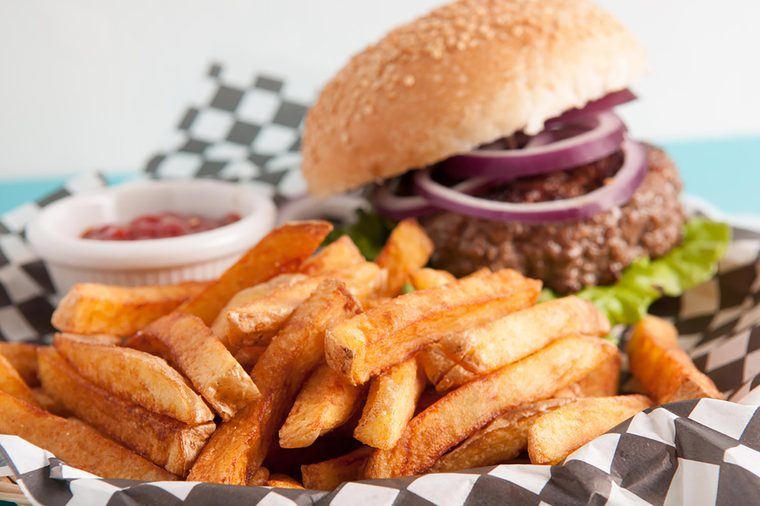
Ordering a combo meal
When you’re on the hunt for a good deal, ordering a combo feels like hitting the jackpot—you get more food for less money! But that combo meal is a raw deal for your waistline. Research from Duke University shows that when you order a combo meal you end up eating 100 to 130 more calories often without even realizing it.
How to fight back:
Simply stick to the main dish or side you were eyeing and grab a cup for water. Saving a few cents on a combo meal at the expense of overeating isn’t worth it if your goal is to keep your weight in check! And make sure you’re not ordering one of these calorie-busting meals when you’re out.

Eating from the wrong plate
Did you know that the plate you’re eating from actually affects how much you eat? Research shows that when you eat from a larger plate, you end up piling more food onto it. The result? You get tricked into overeating. This trick is an optical illusion: When you only fill up half of a large plate, you feel like you’re not eating much—but the same amount of food on a smaller plate would look like a big portion.
The size of your plate isn’t the only thing tricking you, though. The color of your plate can also encourage you to eate more. If the color of your plate matches the color of your food—think mashed potatoes on a white plate—it can be hard to register how much food is really there, and studies show us that matching your plate to your food means you’ll serve yourself about 30 percent more!
How to fight back:
Serve yourself on salad plates and use smaller bowls instead of large dinner plates or huge pasta bowls. Stock your kitchen cupboards with plates of various colors and at your meal, choose dinnerware that contrasts with the food. You might even trick yourself into eating less!
The size of your utensils matter too: Eat with salad forks or coffee spoons rather than large utensils. The smaller your table setting, the bigger your meal will feel, so you’ll be less likely to overeat. Here are more secrets to losing weight without a lick of exercise.
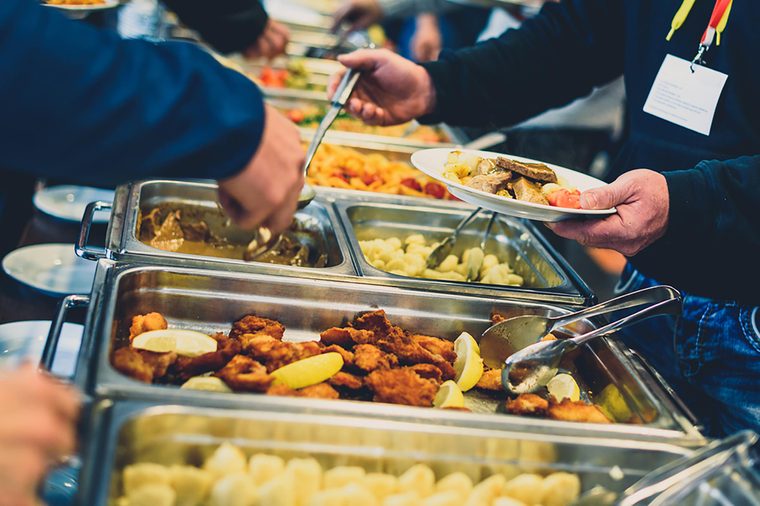
All-you-can-eat restaurants or gatherings
When you’re faced with an “all you can eat” situation, you’ll probably do just that: eat all you can. Research shows that the more choices we have to eat, the more we eat… Because we’re tempted to try a bit of everything!
Even at a “healthy” buffet, like a salad bar, you can fall victim to overeating because you’re not feeling guilty about eating so much healthy food (see sneaky trick #1). All in all, a situation where you are welcome to pile food on your plate endlessly (especially if you’re motivated to get your money’s worth) is an overeating episode waiting to happen.
How to fight back:
See if you can skip the buffet and order a portioned plate instead. If not, here’s how to navigate a buffet like a boss: Scope out all of your options before you put anything on your plate, and make a mental note of dishes you know you will enjoy eating. That way you’ll be able to skip the macaroni salad early on in the line to save space for the fresh grilled veggies, rather than just piling it all on as you come across different dishes.
Stick to one plate and fill it with a balance of veggies, lean protein, and whole grains if possible. Build your plate as if you’re putting together a healthy meal at home, and then stop there instead of going back for more and more. Choose one dessert or indulgence (after scoping out and deciding which one you’ll enjoy most), and leave it at that. When you treat the buffet like a regular menu, you’ll avoid being tricked into more than you’d eat at other restaurants.
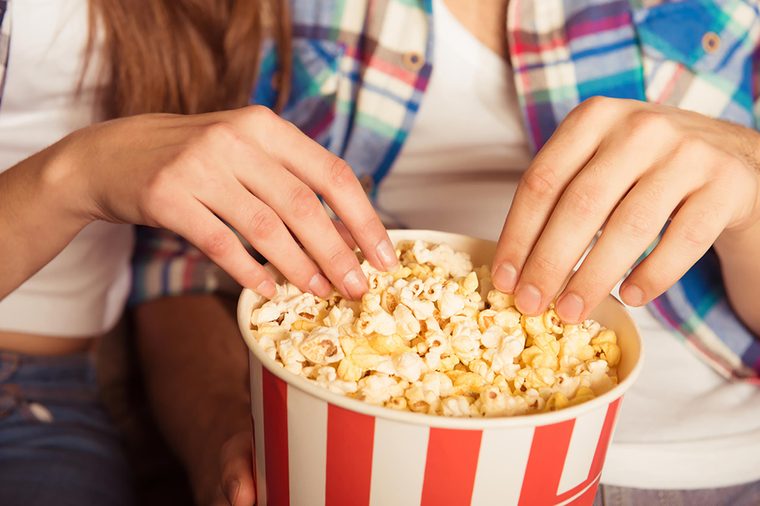
Watching sad movies
Snacking in front of the TV is a recipe for mindless overeating. When you’re paying attention to the screen, not your hand grabbing more food, you end up gobbling without even noticing, and that effect gets heightened when the screen is showing something sad.
A study from the Cornell Food and Brand Lab found that people eat 28 to 55 percent more popcorn while watching sad movies than while watching comedies. That doesn’t mean you have to swear off tear-jerkers, though! You’re only likely to grab the popcorn during a sad movie if it’s in front of you in the first place.
How to fight back:
Keep the popcorn and other snacks out of reach—in the kitchen if you’re at home, or on the floor in the theater (or better yet, skip the junk food snacks all together!). Since you hardly notice when you’re eating in front of the TV, you’ll hardly notice when you’re not eating, and you can save yourself from being tricked. You can also try portioning out a healthy snack to enjoy. And once that’s done, no refills!
Did you know that too much TV can increase your risk of diabetes?
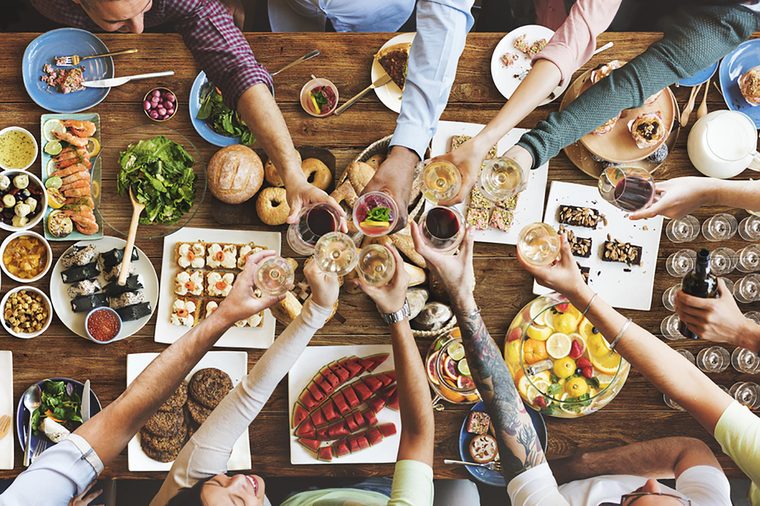
Dining with friends and family
Ever notice how you usually end up overeating when you have dinner out with friends or at family gatherings, but not so much when you’re dining alone or on an awkward date? That’s because dining with the people you’re most comfortable with can actually trick you into eating more. Eating with friends and family tends to extend the time you’re at the table and make you feel relaxed, meaning you end up picking at your food for longer and worrying less about how much you eat.
How to fight back:
When you’re at a restaurant with friends, ask the server to box up leftover food or clear your plate as soon as you’re satisfied. That way, you’ll be able to enjoy conversation without picking at your plate long after you’re full. If you’re sharing a bunch of small plates, fill up your plate once and stick to that portion, rather than helping yourself to dishes a little at a time. That way, you’ll have a much better idea of how much food you’re actually eating.
At family gatherings, use the same strategy: Make yourself one plate and once you’re full, push the plate away from you so you won’t be tempted to nibble more. Despite your Aunt Ida’s insistence that you must have seconds of her famous lasagna, only you can decide when you’re satisfied. Politely decline and change the subject. Ask her how her cats are doing.

Not skipping the ads
The goal of advertising is to make you want whatever you see in the ad, right? Well, that tactic works all too often when it comes to food advertising, triggering us to eat when we see cheese melting over a burger or chips crunching satisfyingly loudly, whether we’re actually hungry or not. Research shows that adults eat more snack foods, both healthy and unhealthy, after viewing snack food commercials.
How to fight back:
Skip or mute the ads during a show whenever possible. If that’s not an option, make sure to pause before reaching for a snack after watching food ads. Ask yourself: Am I really hungry, or just craving this food? Is there a healthier option that would satisfy this hunger or craving? If I do grab a snack (even a healthy one), how can I control the portion to make sure I’m not snacking mindlessly?
If you have a tendency to overeat in front of the TV, get more tips on how to avoid nighttime stress eating.

Seeing a salad on the menu
Ironically enough, sometimes just seeing a salad on the menu can make you feel like you’re making a healthy choice, no matter which salad you choose. Researchers are calling this phenomenon “vicarious goal fulfillment,” and this is how it tricks you into overeating: You see a healthy option on the menu and consider choosing it, and the mere consideration of a healthy choice subconsciously makes you feel like you’ve made strides towards being healthy. But instead of going for the healthy choice, you end up with the most indulgent option on the menu because your brain has already congratulated you for fulfilling your health goals.
How to fight back:
When you see a healthy option and consider it, close the menu and follow through with ordering it. Or if you decide to indulge, do so mindfully, while knowing that what you’re eating is an indulgence. Enjoy a small portion and then get back to making healthier choices most of the time.

Buying the “low fat” snack
Just as you might label a meal as “healthy,” simply seeing the words “low fat” on a food label can trick you into thinking you’re eating something healthier than you really are. What happens is you don’t feel as bad about purchasing a “low fat” treat or snack, and then you don’t feel as bad about eating it. Worse still, eating highly processed snack foods can become a regular occurrence rather than a treat because you’ve told yourself there are no strings attached.
How to fight back:
Steer clear of “low fat” products that trick you into thinking you’re making healthy choices when shopping for processed foods. Instead, snack on real foods that don’t even need claims on labels (think fruits, veggies, and foods with filling healthy fats such as nuts and avocados) for your daily snacks. You need healthy fats to help you feel full and so your body can absorb vitamins A, D, E, and K.
It’s also important to treat yourself to whatever higher fat foods you’re craving every once in awhile. You’ll end up enjoying the full fat version of your favorite foods a lot more than you would if you had the less delicious low fat version every day. Plus, you’ll eat fewer calories each week rather than being tricked into overeating.
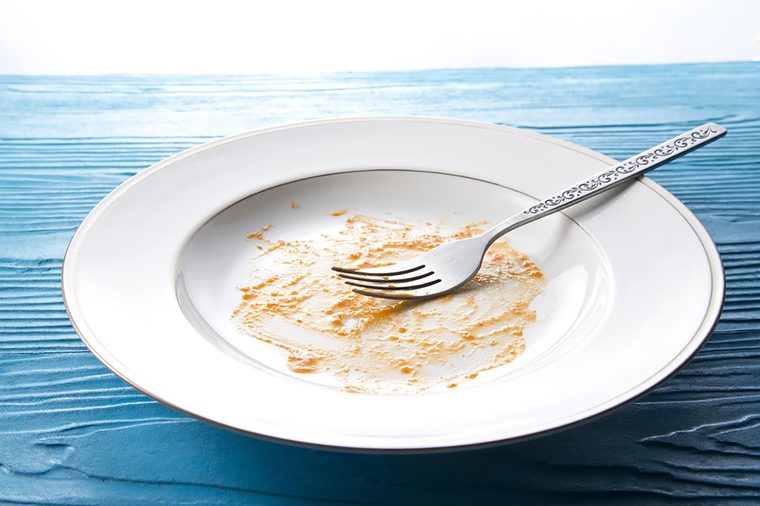
Guilting yourself into cleaning your plate
Did your mom always tell you to finish everything on your plate when you were growing up? Well, that technique might be helpful for getting kids to choke down their broccoli, but it’s not doing you any favors if you’re trying to avoid overeating. Guilting yourself into eating every last morsel on your plate means that you’re probably eating more than you’re hungry for.
How to fight back:
No one wants to waste food, but if you’re full before your plate is clear, just save the leftovers. At restaurants, make a mental note of how much you’re actually hungry for—maybe most of the dish, but with some left over to make a side dish for lunch tomorrow? Stop when you reach that point, and save what’s left.
When loading up your own plate, stick to a small plate and a reasonable portion so that you can check in with yourself when that plate is finished, rather than starting out with eyes that are bigger than your stomach. If you find you’re eating more than you need because of guilt or other challenging emotions, read more about emotional eating and tips to help break the habit.
